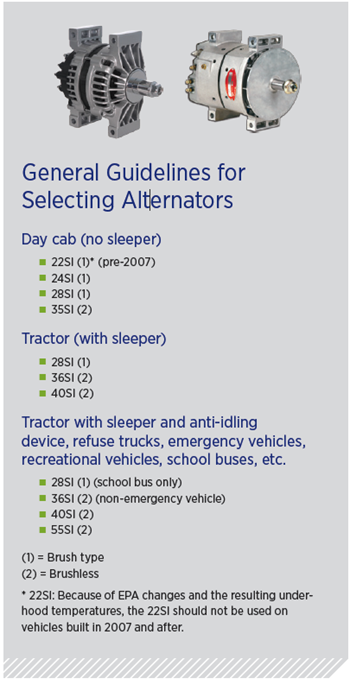
When you need an alternator for heavy duty vehicle applications, how do you choose one from our broad selection? Regional Sales & Service Manager Nick Tosie shares what you need to consider when selecting an alternator to best fit your needs.
Mounting Style
“The first decision is always mounting style,” Tosie explains. “This is the logical starting point since you have to actually mount the alternator to the vehicle, so your selection is immediately narrowed.”
The two predominant mounting styles are:
- Hinge Mount: This mount—distinguished by two mounting feet and one adjusting ear—is generally used on vehicles more than seven years old.
- Pad Mount: Almost all over-the-road vehicles use this mounting style which has four mounting pads bolted directly to the engine block.
Note: If a Delco Remy alternator is what you are replacing, then use the short hinge mount. If you are replacing a Leece Neville alternator, use the long hinge for non-adjustable mount applications typically found on IC Buses.
Brush vs. Brushless
The next point in selecting an alternator is deciding between brush and brushless.
“If you intend to use an alternator less than two years, then brush is best,” Tosie says. “If it’s a longer time than that and includes lots of coast-to-coast driving and/or a long trade cycle, then brushless is better. While you may pay nearly twice as much for brushless, it will last about four times as long.”
Alternator Output
All alternators are listed at maximum output. Since alternators are rotational devices, the output listed is at approximately 5,000 RPMs, shaft speed. The alternator pulley is much smaller than the crankshaft pulley, so it is turning much faster than the engine RPM (generally 3.5:1, up to 4:1 ratio). This means that the alternator is well into its maximum output when the vehicle is going 65 mph.
The vehicle duty cycle is the most important factor when selecting output. A truck that hauls produce cross-country will be at highway speeds most of the time, whereas a city delivery vehicle, with a lot of stops and idling, may benefit from an alternator with more output
at slow speeds.
“An alternator should provide greater output than the vehicle requires,” Tosie explains. “It’s okay to go up in output, but not down.”